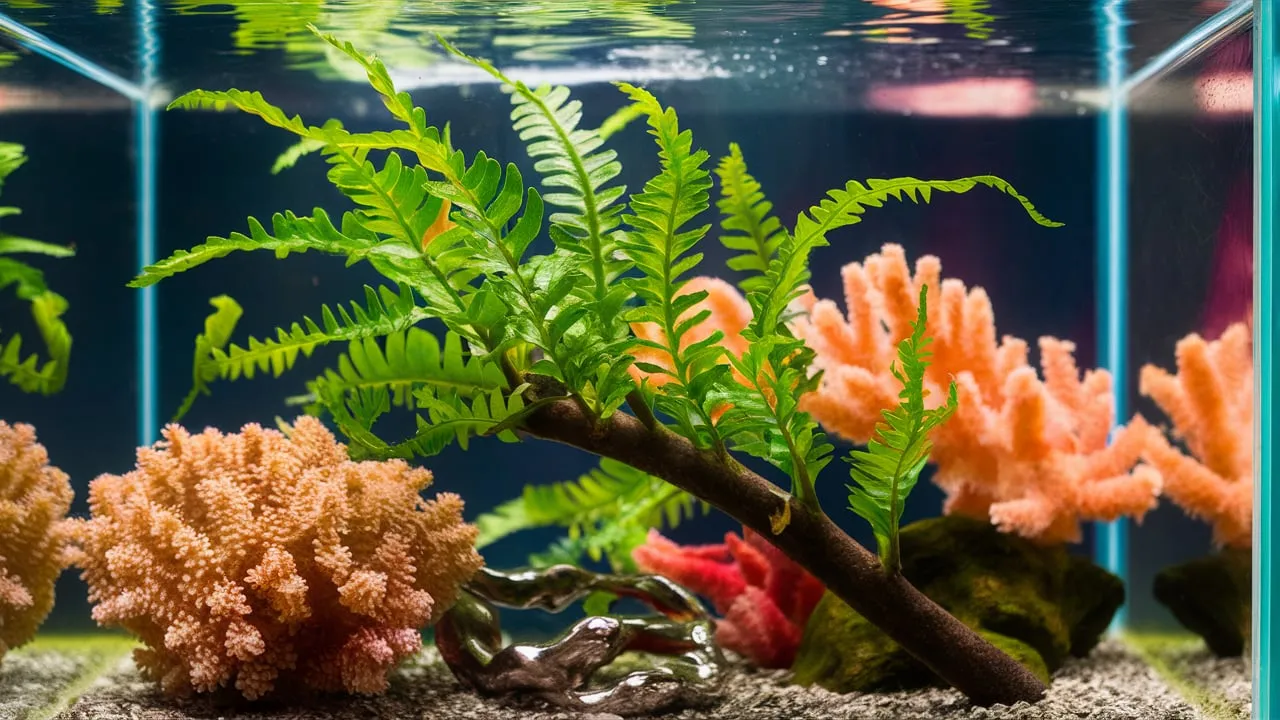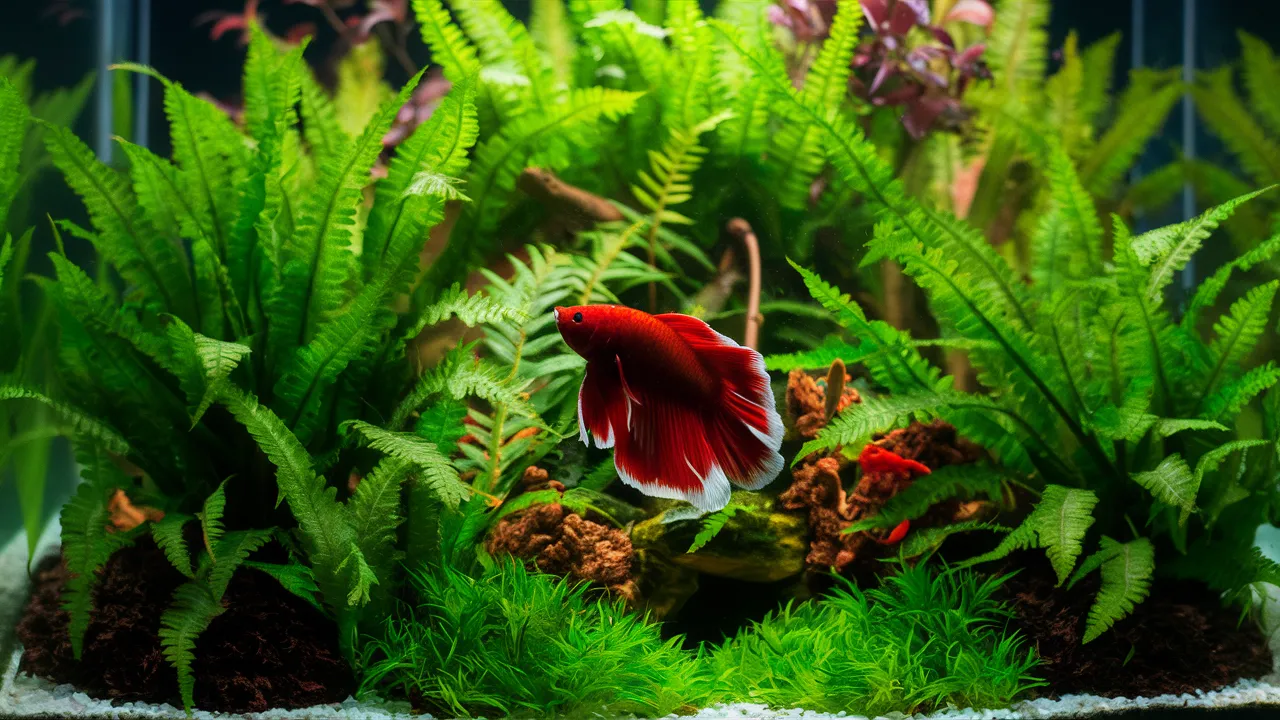Java Fern For Betta with its hardy nature and aesthetic appeal, has become a staple in betta tanks, offering numerous benefits for both the fish and the overall aquarium ecosystem.
This Betta Fish Guide explores the advantages of Java Fern for betta fish, provides detailed care instructions, and addresses common questions about this popular aquatic plant.
Understanding Java Fern
Java Fern is a species of aquatic fern native to Southeast Asia, sharing its origins with our beloved betta fish. This natural connection makes it an ideal choice for creating a harmonious and natural environment in your betta aquarium.
Characteristics of Java Fern
- Scientific Name: Microsorum pteropus
- Family: Polypodiaceae
- Origin: Southeast Asia
- Growth Rate: Slow to moderate
- Maximum Size: 12-14 inches (30-35 cm)
- Light Requirements: Low to moderate
- CO2 Requirements: Low
Java Fern is prized for its resilience and adaptability, making it an excellent choice for both novice and experienced aquarists. Its lush, green leaves provide a natural backdrop that complements the vibrant colors of betta fish, creating a stunning visual display in your aquarium.

Java Fern Varieties for Betta Tanks
There are several varieties of Java Fern that can add diversity to your betta’s habitat:
Narrow Leaf Java Fern (Microsorum pteropus ‘Narrow’)
- Slender, elongated leaves
- Creates a more delicate appearance
Trident Java Fern (Microsorum pteropus ‘Trident’)
- Leaves split into three or more points
- Adds unique texture to the aquascape
Windelov Java Fern (Microsorum pteropus ‘Windelov’)
- Leaf tips are deeply forked and lacy
- Provides an intricate, decorative element
Each variety offers unique aesthetic qualities while maintaining the same beneficial characteristics for your betta’s environment.
Benefits of Java Fern in Betta Tanks
Incorporating Java Fern into your betta’s habitat offers numerous advantages:
- Natural Shelter and Resting Spots
Betta fish appreciate areas where they can hide and rest. The broad leaves of Java Fern provide perfect natural shelters, allowing your betta to feel secure and reduce stress.
- Oxygenation and Water Quality
Like all live plants, Java Fern contributes to oxygenation of the water through photosynthesis. It also helps maintain water quality by absorbing nitrates and other waste products.
- Algae Control
Java Fern competes with algae for nutrients, helping to keep algae growth in check and maintain a cleaner aquarium environment.
- Low Maintenance
This plant is incredibly hardy and can thrive in a wide range of water conditions, making it ideal for beginners or those who prefer low-maintenance aquascaping.
- Breeding Support
The broad leaves of Java Fern can serve as excellent surfaces for betta bubble nests, supporting natural breeding behaviors.

How to Introduce Java Fern to Your Betta Tank?
Adding Java Fern to your betta’s habitat is a straightforward process, but there are some best practices to ensure success:
Proper Planting Techniques
Unlike many aquatic plants, Java Fern should not be planted in the substrate. Instead:
- Attach it to driftwood, rocks, or other decorations using aquarium-safe thread or glue.
- Allow the rhizome (the horizontal stem) to remain exposed to prevent rot.
Lighting Requirements
Java Fern thrives in low to moderate lighting conditions:
- 1-2 watts per gallon of low to moderate output LED lighting is sufficient.
- Avoid strong, direct light to prevent leaf burn.
Water Parameters
While adaptable, Java Fern prefers:
- Temperature: 68-82°F (20-28°C)
- pH: 6.0-7.5
- Hardness: 3-8 dKH
These parameters align well with the preferred conditions for betta fish, making Java Fern an ideal plant companion.
Caring for Java Fern in Your Betta Aquarium
Maintaining a healthy Java Fern is crucial for the overall health of your betta’s environment. Here are some care tips:
Pruning and Maintenance
- Remove any yellow or brown leaves to encourage new growth.
- Trim larger leaves if the plant becomes too large for your tank.
Fertilization
While not strictly necessary, light fertilization can promote healthier growth:
- Use a liquid fertilizer designed for aquarium plants, following the manufacturer’s instructions.
- Avoid over-fertilization, as this can lead to algae problems.
Propagation
Java Fern reproduces through spores and plantlets:
- Small plantlets will form on the leaves’ edges.
- Once these plantlets develop roots, gently remove them and attach them to new surfaces in the aquarium.
Common Issues and Solutions
Even with its hardy nature, Java Fern can encounter some problems. Here’s how to address them:
Browning Leaves
- Cause: Often due to too much light or lack of nutrients.
- Solution: Reduce lighting intensity or duration, and consider adding a gentle fertilizer.
Slow Growth
- Cause: Insufficient nutrients or poor water quality.
- Solution: Ensure regular water changes and consider adding a balanced aquarium fertilizer.
Algae Growth on Leaves
- Cause: Excess nutrients or lighting.
- Solution: Reduce feeding and lighting, increase water changes, and consider adding algae-eating tank mates compatible with bettas.
Conclusion
Incorporating Java Fern into your betta’s aquarium is a decision that benefits both the fish and the aquarist. This versatile, low-maintenance plant not only enhances the aesthetic appeal of your tank but also contributes to a healthier, more natural environment for your betta.
Remember, every aquarium is unique, and what works best may vary depending on your specific setup and the individual needs of your betta. We encourage you to experiment, observe, and adjust your approach to find the perfect balance for your aquatic ecosystem.

Related Posts
Culture Of Infusoria In The Tank: A Microscopic Feast for Fry
Almond Leaf For Betta: A Natural Habitat Enhancer
Clamped Fins On Betta: Causes & Treatment